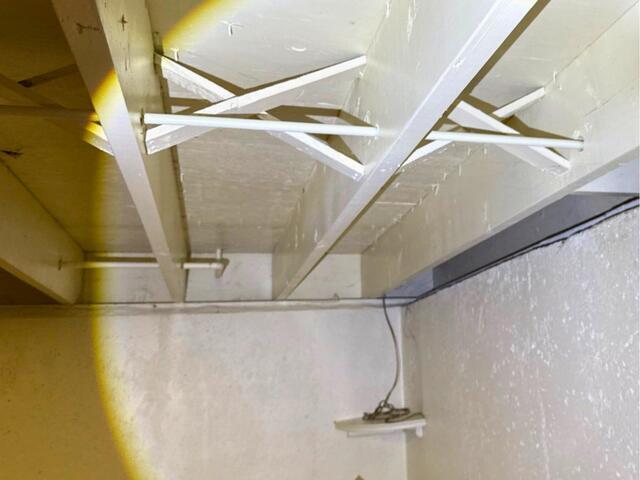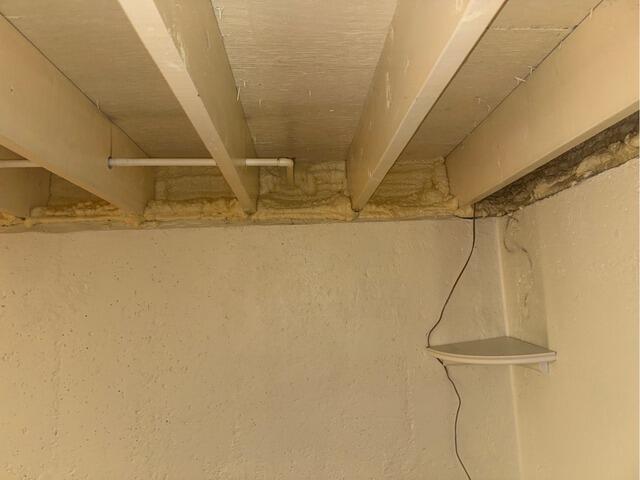Before & After Photos
Click on a photo to enlarge.
Spray Foam to Seal & Insulate Leaky, Poorly Insulated Rim Joists in Manchester, CT
This Manchester, CT customer reached out to Fogarty's Home Services for a Free Home Energy Evaluation to determine why her home was experiencing drafts and coldness. One of the issues we found was leaky & poorly insulated rim joists. The "rim joist" is the perimeter of the floor framing system along the exterior of the house. The joints and gaps between all the framing members allow for a lot of air leakage into the house. The rim joist is seldom insulated and never air sealed. Basement ceiling insulation, especially fiberglass batt insulation, doesn't stop the flow of cold air into the home. This explains why our customer had a drafty, cold house. To fix our customer's uncomfortable home, we installed two-part expanding spray foam on the rim joists and over sill plate to seal all air leaks from the outside and insulate the area. Fogarty's Home Services uses a Dr. Energy Saver spray foam with a high insulation value per inch of R7, and because it expands, it seals all cracks, gaps, and joints where air from the outside enters your home. Now our happy customer will feel the results, which include warmer floors, less drafts, more comfortable rooms, and lower energy bills.
Insulating an Attic in Manchester, CT
This homeowner reached out to us hoping that we could evaluate his attic. He had a mold issue, and his insulation was insufficient. Since attics are vented, we should think of them thermally as outside in the winter. In summer because of the suns radiant heat, they are much worse than outside, reaching 130˚ on summer days. Clearly, we need to keep an absolute boundary between our living space and the attic so inside air doesn’t move to the attic in the heating season (convection), and heat doesn’t pass up through our ceilings in winter (conduction), and down from our ceilings in the hot summer (conduction, radiation). To reduce overall air leakage, the attic is the first priority because warm air rises to the top of the house and finds any and all holes to leak out into the cold vented attic and is lost. Holes, gaps and joints include between drywall and framing at the top of walls, around pipes, wires, electric boxes, fixtures, duct, penetrations, ceiling grilles and joints in framing. And the only reason cold air leaks in from the outside at the lower levels of the house, is that warm air leaked out of the top and created a suction at the bottom.
We had the perfect solution for this customer. Adding insulation in an attic without sealing all air leaks first should never be done, because it is just burying air leaks and making them impossible to seal later - and insulation DOES NOT STOP air leaks. That’s why, in this solution, we first carefully air seal the many various points where air from the home leaks up into the attic and is lost. Our premium TruSoft™ cellulose insulation is blown to the optimum R-value (typically R60). TruSoft™ will not burn, get moldy, or attract pests. Blown insulation fills all gaps and odd shaped voids, and by filling over framing members, “thermal bridging” is avoided.
Insulating a Basement in Manchester, CT
This homeowner in Manchester, CT initially called us after his HVAC contractor recommended he get his attic insulation replaced. When our Home Comfort Specialist came out to the home, the homeowner noted that he had high energy bills. He also stated that he had a rodent issue that he needed to address.
We had the perfect solution for this customer! We utilized two-part expanding spray foam. We insulated the rim joist (the perimeter of the floor framing system along the exterior of the home). We spray this foam in the rim joist and over the sill plate. Insulating the rim joist in this way seals all air leaks -- filling in the cracks and gaps that are present there. This prevents outside air from getting into the home. The homeowner is now very happy, and he is much more comfortable in his home!
Insulating Can Lights in East Longmeadow, MA
This home owner in East Longmeadow, MA called us to see if we could make his home warmer in the winter. When we got into his attic we noticed that not only was there little to no insulation, but there was also can lights. Can light can let up to 10 CFM's of air that you paid to heat your home escape into your attic. When you have multiple can light like this home does, it could be effecting the temperature in the house and your wallet! To fix this issue, we use our Tite-Shell can light covers. Because can lights get so hot you can use traditional insulation or it could burn. Instead our can light covers are made with rock wool. This is a material that is a by-product of the molten steel industry. IT has been burned up tp 2000+ degrees to make it practically fire proof. Once we get the shell to fix right we air seal around it. after doing all the can lights, this house is just one step closer to becoming more comfortable and energy efficient!
Insulating Roof with TrueSoft in East Longmeadow, MA
Team dense packed roof with TrueSoft Cellulose













